Helping dogs and cats lose weight
We recommend consulting your vet before putting your dog or cat on a diet.
Obesity is a health risk, so it’s important to ensure your pet has no related medical conditions. Some weight problems are caused or exacerbated in the first place due to metabolic diseases, certain drugs or rare genetic defects.
You will need an accurate starting weight, and a target weight. The latter can be estimated using breed standards, but due to individual variation, it is safer to ask your vet’s professional opinion (especially if you own a cross-breed). Your vet will be able to assess the visual and palpable characteristics that correlate subcutaneous fat (fat under the skin), abdominal fat (belly fat) and superficial musculature (e.g. ribcage, dorsal spinal processes and waist). This is called body condition scoring, and it is a very helpful adjunct to the scales. It’s best to use the same scales for your pet’s weight checks.
We don’t intend to take the place of your vet, but can offer extra support and motivation. We can suggest suitable foods and appropriate volumes that are based on your pet’s individual energy requirement and the calorie content of the products, and guidance if you encounter any difficulties.
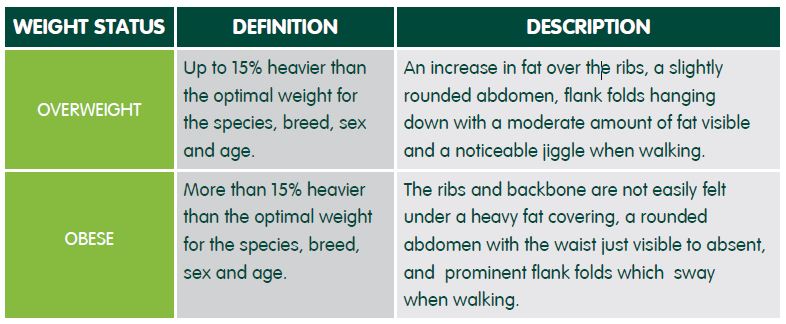
Resolving a weight problem means less stress on the joints, circulation and other vital bodily tissues, organs and systems. Maintaining a healthy weight reduces the risk of your pet developing obesity related illness and ultimately will help improve your pet’s health and well-being.
Once a pet becomes obese, a vicious cycle can develop. The extra weight can make it difficult to exercise due to adverse effects on locomotion, heart function, respiration and the metabolic rate; and the less energy expended – the greater the risk of further weight gain. Breaking the cycle requires diet, exercise (careful and controlled), stimulation and motivation.
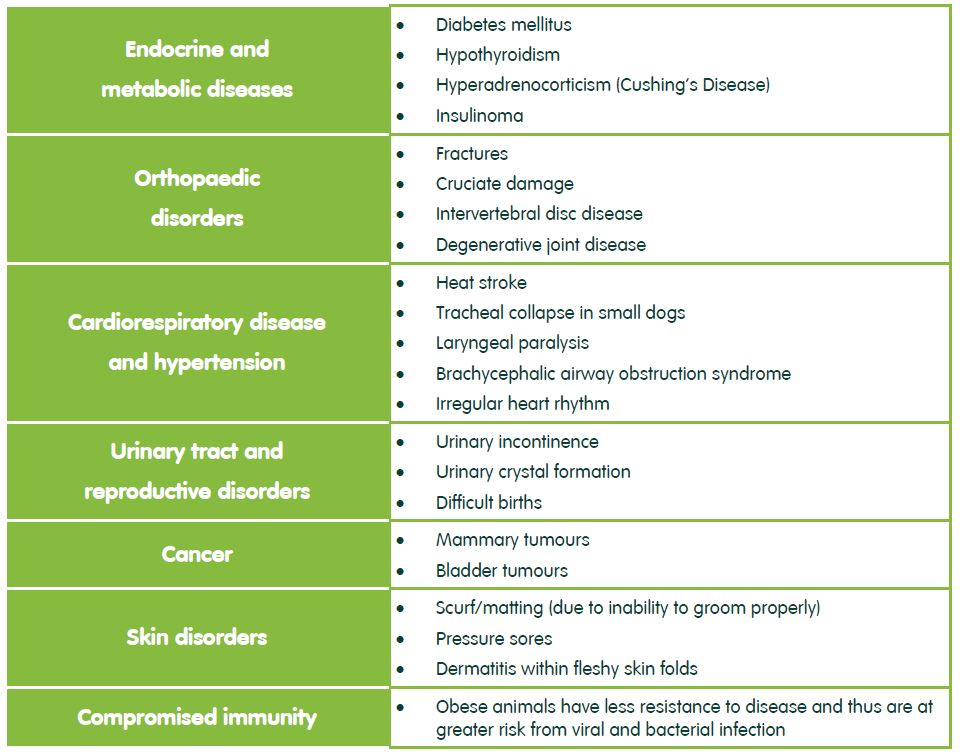
Helping your pet to lose weight is not a guarantee that they will never suffer from any of the conditions listed, but it can reduce the risks. We are in charge of our pets’ food intake, and it is therefore down to us to know when restriction is necessary and implement changes to ensure a healthier lifestyle for them.
The most effective way to achieve and maintain your pet’s target weight is by gradually introducing life-style changes which are realistic and sustainable. If your pet has a lot of weight to lose, it can be helpful to set an interim target to work to. This avoids dramatic reductions to the daily food intake which can come with its own set of problems that might include constipation, loss of energy, a slower metabolic rate and slower weight loss (as the body will want to hold onto its fat reserves), and even nutrient deficiencies if the animal is not being fed enough for a significant time period. The end result is an unhappy, hungry animal. Hunger can lead to undesirable behaviours including begging, scavenging and coprophagia (stool eating).
As a general guide, we would anticipate weight loss of up to 5% of your pet’s starting weight in the first month of the diet, followed by a steadier loss of 1-2% per month thereafter.
Dieting pets will need fewer calories than they have been used to (up to about 25% less than the amount needed for maintaining their healthy target). Some cats and dogs may not mind a reduction (especially if the amount is brought down gradually to allow the stomach time to contract slowly and the digestion to get used to less food), but animals with a large appetite may not tolerate this so well; especially obese pets, where considerable reductions may be indicated. For these animals, our lower calorie Light diets are often a good option. With significantly less fat than our adult maintenance diets, daily allowances are higher.
We can also incorporate wet (or fresh) food into your pet’s diet. This can be beneficial due to it being less calorific than dry due to its much higher moisture content. 100g of Arden Grange Adult Sensitive dry dog food supplies 369 kcals, but one quarter of a can (just under 100g) of our Partners Sensitive wet dog food supplies only 81 kcals, meaning it’s a very effective way to increase the amount the animal can eat without exceeding the calorie requirement.
We can even include a moderate quantity of appropriate, healthy treats. Dieting pets don’t need to completely go without; we just need to ensure the main diet is suitably reduced to allow for the extra calories they provide.
We can even include a moderate quantity of appropriate, healthy treats. Dieting pets don’t need to completely go without; we just need to ensure the main diet is suitably reduced to allow for the extra calories they provide.
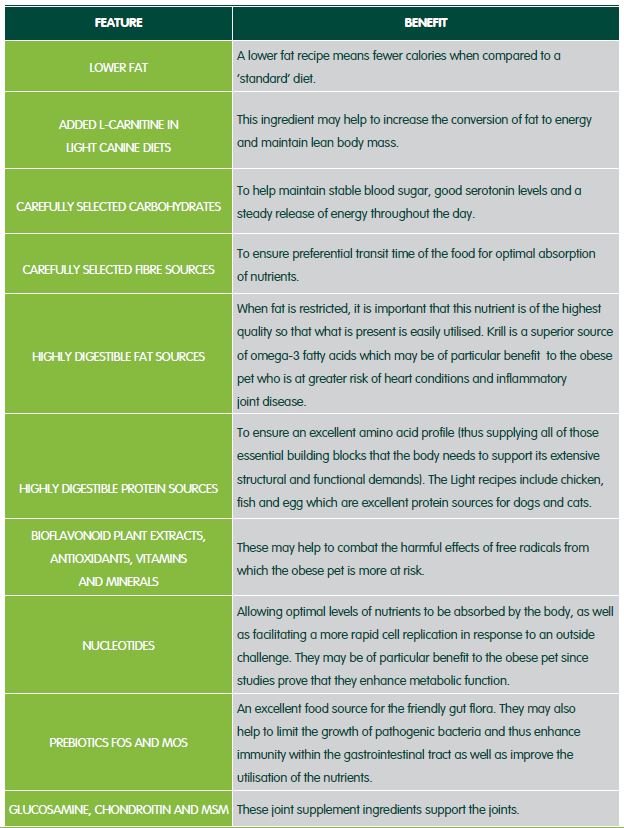
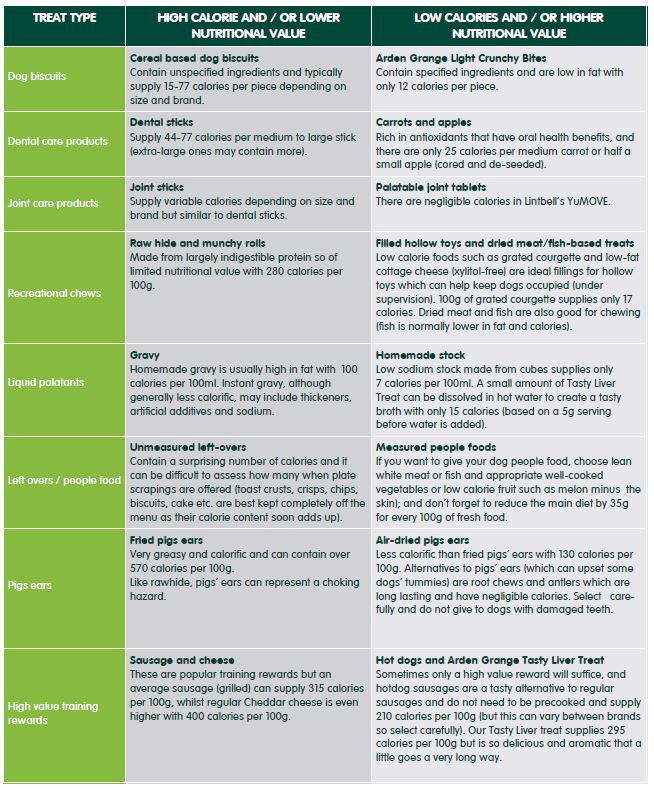
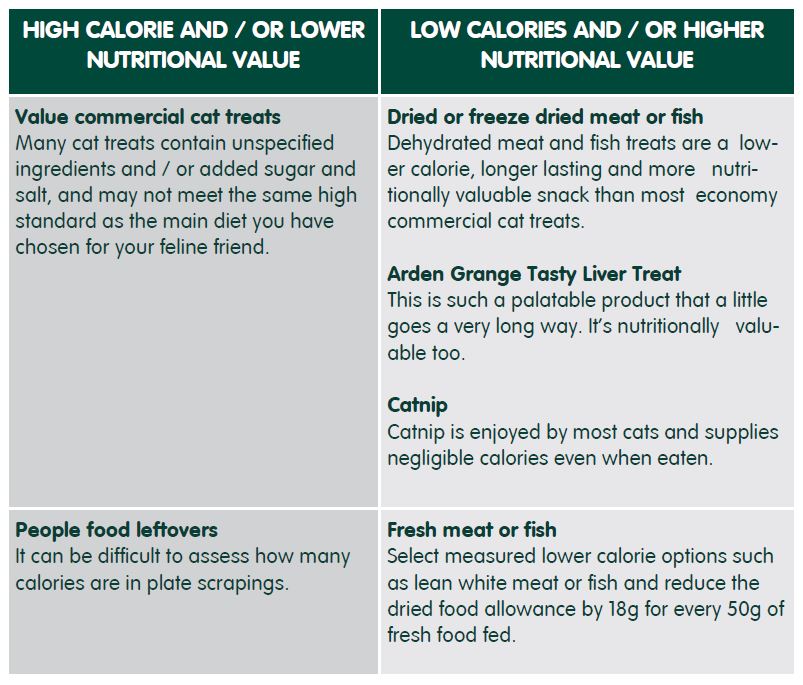
Use treats in moderation only (e.g. as a reward for good behaviour and for training, not just because). Dogs and puppies like to work for their rewards, and it helps to stimulate their brains. Psychological exercise is just as important as physiological exercise. Valuable food rewards can be a really important aid to training, but make sure you use them for that and not just because you think a little bit of extra food is going to appease your pets and keep them happy if they are under stimulated in other ways.
Vets generally recommend that treats do not supply more than 10% of the animal’s daily calorie intake (to avoid unbalancing a complete pet food).
We can help with the calorie counting and devise a menu that includes a moderate amount of treats, but if you are feeding commercial dry food and want a quick and simple solution – simply weigh the amount of (dry) treats you would give on an average day and deduct this amount from the usual daily volume of the main diet. If any of the treats have a significantly higher fat (or oil) content listed than the main diet, then reduce the allowance a little more (or consider a treat that has a comparable or lower fat content). One gram of fat supplies more than double the calories of one gram of protein or carbohydrate. Reduce the treat intake if the weight exceeds 10% of your pet’s main dry diet allowance, or if you need to use more than this for training purposes, set aside some of your pet’s dry food allowance to use for treating.
If you want to give an extra treat for a special occasion such as a birthday, then why not take your dog out for a longer walk, or play an extra game with your dog or cat to burn off some more calories? If your pet has many treats to mark a special event, feed them instead of, not in addition to, one of his or her main meals, and try not to do this too often.
Adding healthy and appropriate fresh food to a commercial diet can be a very good way to increase the volume for cats and dogs with a large appetite. If you wish to add to your pet’s menu, choose low fat options like grated or steamed courgette/apple/carrot with white fish or lean white meat, and reduce the amount of any commercial dry food by 35g for every 100g of fresh food given. Good quality commercial complete wet food such as the Arden Grange Partners ranges can also be used. Very low fat additions may necessitate less of reduction whilst higher fat foods may necessitate more, but this should provide a reasonable starting point.
Different sources have different opinions on what constitutes the ‘best’ food for weight loss. The best food is the one that is most suited to the individual.
Some advocate high protein low carbohydrate diets, based on the principle that protein is generally used for structural and metabolic functions, whilst carbohydrates are more likely to be converted and stored as body fat. This is true, but only in the event of excessive carbohydrate consumption, and only if the animal’s calorie intake exceeds expenditure. For animals who do fare better with this type of nutrient balance, the Partners wet food ranges meet the high protein low carb criterium. Be wary of very high protein, low carb dry foods for dieting pets because they are generally high in fat, and the subsequently smaller feed portions may not be suited to animals with a naturally large appetite even though protein is important for satiety.
Some weight loss diets are lower in fat (and subsequently calories) than regular diets. This type of product has a moderately high carbohydrate content, but when fat is restricted, the carbs are used primarily as fuel for energy, and many animals can lose weight very successfully on them. Our Light diets meet this criterion.
Exercise is an important part of obesity management and will help burn calories and increase the resting metabolic rate. Care must be taken with obese or very unfit animals, particularly if these pets suffer from medical conditions related to their excess weight. Little and often is the way forward, and gradual increases to the daily exercise will reduce the risk of fatigue and injury. Swimming at a hydrotherapy pool (with expert supervision) is an excellent means of exercise for obese dogs. Even cats can be encouraged to exercise! Why not place the feed bowl at the top or bottom of the stairs so that your cat has to go up or down them before eating. Many cats can be encouraged to use indoor “cat trees” and climbing apparatus, and cat nip is a great way to get most cats moving. Play-time is both physically and mentally stimulating for your pet, so be sure to invest in some new and interesting toys to keep up interest.
Before you embark on your pet’s weight loss journey, you might like to complete a food diary for a few days. Be completely honest, and record everything you feed on a typical day including the weight or quantity and the time fed (include main meals, and ALL treats and extras). It will help us to work out where reductions or substitute foods can be given without upsetting your cat or dog’s usual routine too dramatically.
You may have always fed once or twice a day, and this suits most dogs and cats. However, for dieting animals, sometimes it is helpful to increase the frequency of the feeds to three meals per day. This may help to promote more stable blood sugar and good serotonin levels. Serotonin (the “happy hormone” plays an important role in dietary satisfaction. The additional feed adds interest to the day too. Use a smaller bowl; the feed portions won’t look as little, and this can be psychologically advantageous for the humans helping with the weight management plan. Do be very careful not to exercise dogs too near to their mealtimes though because this may increase their risk of bloat. Dogs and cats (particularly if they are rapid eaters) may benefit from interactive feeding toys (which should always be used under supervision).
Another tip is to keep the day’s treat allowance in a container for use at particular times. This avoids the temptation to keep dipping into the packs and offer other unscheduled extras. Once the day’s treats have finished, that’s it until tomorrow.
Counting calories is not the be all and end all when devising a weight loss plan, but it does provide something tangible to work with at the outset. It is also no secret that weight gain happens when the calorie intake exceeds what the body needs to maintain condition and provide energy. Medical, genetic and environmental factors may play a part too. Identifying why your pet is over-weight can help you to make life-style changes which can reduce the risk of unwanted weight gain in the future as well as address the current problem.
Ageing
We cannot reverse the ageing process, but by being aware that animals start slowing down (and expending less energy) as they get older, we can make adjustments to their nutrition and reduce the calorie intake accordingly. Obesity is more common in geriatric animals because they have the added challenge of declining lean muscle mass and an accumulation of fatty tissue.
Neutering
Neutering is often blamed for weight gain because the animal no longer has the hormonal urge to expend energy looking for a mate. Hormonal changes can also cause an increase to voluntary appetite and reduce the metabolic rate. Some vets suggest a special diet for neutered dogs and cats, but the Arden Grange Light products may be a suitable alternative as they have similar attributes. Equally you could feed less of the pet’s regular diet.
Metabolic Rate
Just like people, some dogs and cats simply burn more fuel than others, even if their activity level is very similar. The rapid fuel-burners need more calories. Animals with a naturally faster metabolic rate tend to be “on the go” more, and at home they are usually the pets who interact most and rest less. Certain things can speed up the metabolic rate, but they are not always good things; e.g. stress.
Appetite
Some animals are naturally greedy, whilst others might be hungrier due to medication such as steroids. There are lots of ways to improve satisfaction even if you are restricting calories which include interactive feeding toys, timing meals to ensure a feed prior to the period/s the pet appears hungriest and selecting lower calorie products with more generous allowances. Keeping your pet satisfied and happy is crucial to a successful diet.
Competition
Competition at meal-times in multi-pet households can result in overly rapid ingestion and over-eating if the fastest to finish is straight into the other animals’ bowls. Allowing pets to eat alone (thus reducing social pressure) can be helpful.
Lack of mental stimulation
Bored or frustrated animals often want to eat more because they have nothing better to do. If food is unavailable, they might seek inappropriate material to eat including rubbish, plants and faeces. Environmental enrichment is especially important for indoor cats. Rotating a variety of safe and stimulating toys helps maintain interest.
Lack of exercise
Reduced exercise is sometimes necessary (e.g. recovering after surgery), and the food intake must be reduced to allow for the lower energy requirement.
Healthy pets should maintain a good level of activity. Exercise is good for the soul as well as the body!
Inappropriate diet
Feeding in excess of a pet’s nutritional requirement is the primary cause of obesity; this may be as a result of feeding overly high volumes of the animal’s regular diet (especially if free-feeding without applying a daily limit), high calorie people food, excessive volumes of treats, or feeding home prepared diets where it is difficult to assess the nutritional value (and feeding guidelines are absent). Even a moderate amount of extras can supply a surprising number of calories. You don’t need to totally cut out treats, but it’s vital to make sure they are healthy ones, and that the main diet is reduced to allow for those extra calories.
Owner psychology
Owners may often misinterpret their pets’ behaviour and assume that they may be hungry when contact is initiated. Food is often used as a reward when training and it’s very useful. However, it should not be the animal’s only reward. Most pets work well for praise too, and dogs can soon become motivated by a game with their favourite toy.
Once your pet has reached his or her goal weight, there may well be scope for a small increase in food to prevent further weight loss, particularly if more energy is being expended. Be careful not to lapse into old bad habits, though.
Continue to monitor the feed volume, treat in moderation and reduce main diet if extras are given. If you want to give some people food for a special occasion – give it instead of the normal meal, rather than as well as.
Bear in mind that a lighter body requires less energy to carry it, so some pets will reach a natural plateau on their weight loss allowance and may not require an increase. This is particularly relevant if the animal’s activity level remains unchanged before, during and after the diet.
If you have tried, unsuccessfully, to help your pet lose weight in the past, think about the reasons why the diet didn’t work. We can then try to help you avoid the same problem again.
This is the primary reason diets fail, but it is not always the fault of the owner. Other members of the household may be slipping the pet extras without the owner’s knowledge. Sometimes this can be accidental, e.g. young children dropping food which the pet is then able to access. To help prevent this, it’s important to have the whole family (and any other people who interact with your pets on board). If you have children at an age where dropping food is unavoidable, keep your dieting pets out of the room they are eating in until the meal is finished and any mess has been cleaned up.
Animals can be pretty clever at supplementing their menu, and may be accessing food left out for other animals such as wild birds and hedgehogs. Outdoor cats may hunt and eat prey, whilst dogs are natural scavengers. It is difficult if not impossible to discourage cats from hunting (although a bell on a safe collar may help to some degree), so a solution may be to reduce the main diet further to allow for the calories in the additional food. If you have an outdoor cat, he or she may even be entering other houses via a cat flap and accessing food. Dogs are less likely to scavenge if they are satisfied, but voracious eaters may need to be kept on the lead or muzzled outside to prevent them from picking up food remains on their walks. Keep people and pet food well out of reach, and make sure waste bins are cat and dog proof.
Medical conditions should have been ruled out prior to embarking on the diet, but an animal may have developed a new problem since the onset of the diet. Speak to your vet if you are having difficulties helping your pet to lose weight and cannot attribute the cause to anything else.
It is not unusual for a pet to reach a plateau where the weight remains the same or even increases a little. This can be disheartening, but is usually easily resolved with a further small reduction to the calorie intake or if possible, more exercise to kick-start weight loss again. Keep a weight loss chart so you can look at the progress overall rather than just week to week which will be more motivating when you can see a general downward trend. You can measure your pet’s waistline too, and remember the muscle is heavier than fat so if your pet is looking more toned, that’s very positive.
This can be due to a variety of reasons such as ageing, neutering or enforced rest following injury or surgery. It could be that you are unable to provide as much activity as normal due to illness or other commitments. If this is the case, reduce food by a further 5-10% and monitor closely. If you know you are going to be unable to exercise your dog for a significant period, enlist a friend or family member to help or employ a dog walker.
It can be very hard to implement all of your good intentions if there are other people in the household that aren’t on board. If this is the case, then it’s a good idea to keep the daily treat allowance in an easily accessible tub that’s clearly marked. Make sure your family / house mates know that when the tub is empty, other treats are not allowed. If you suspect fellow carers are not going to feel this is enough, then reduce some of your dog’s main food allowance (if fed commercial dry food) and add this to the treat tub to allow for a little more flexibility.
If you can’t put your finger on why successful weight loss is proving elusive, you could perhaps consider filming your pet. There are apps for mobile phones and devices that can be fitted to your pet. This may shed some light if there are any mysterious circumstances.
Important note As a responsible and ethical company, Arden Grange fully appreciates the caution that must be taken when discussing the potential benefits of our diets and the natural supplements included within them. Whilst our products and guidance may be beneficial in helping overweight pets to slim down and lead a healthier life-style, we must emphasise that they are not a substitute for professional advice from your veterinary surgeon.
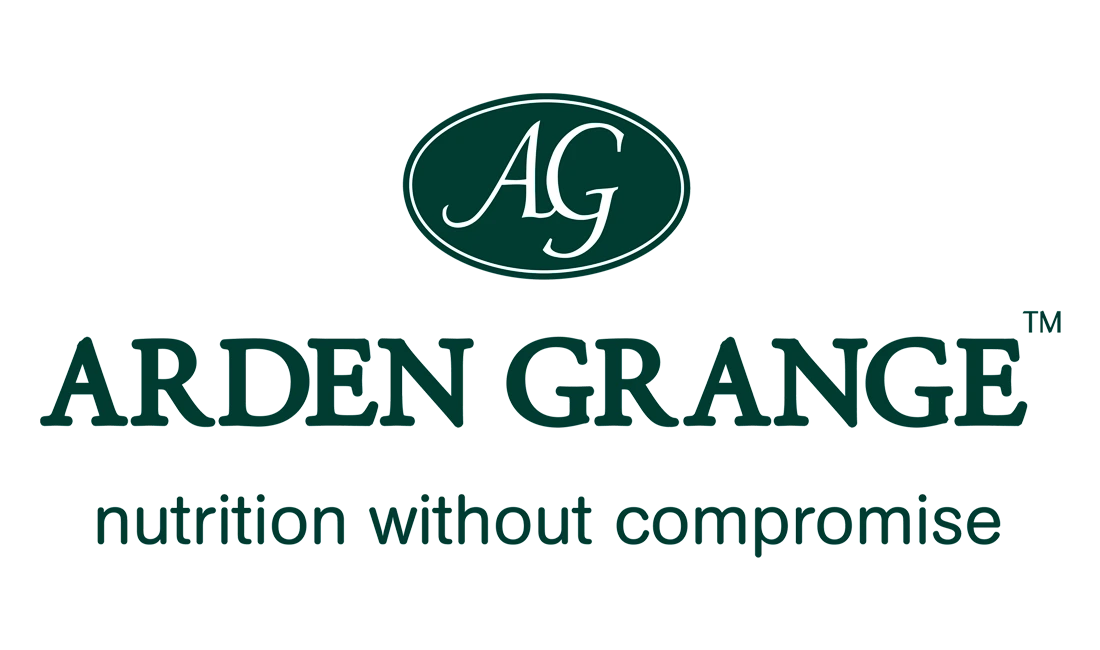

 Puppy
Puppy
 Adult
Adult
 Senior
Senior
 Sensitive
Sensitive
 Treats
Treats Kitten
Kitten
 Adult
Adult
 Senior
Senior
 Trusted British Brand
Trusted British Brand

